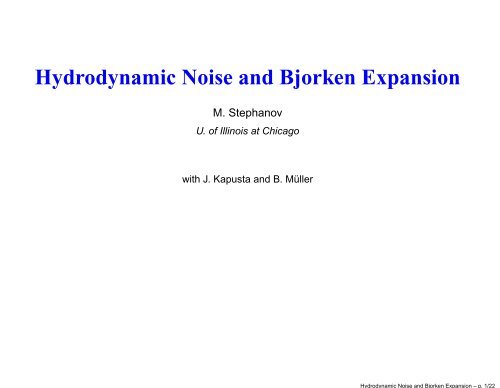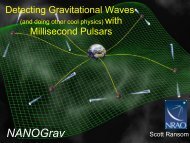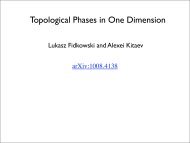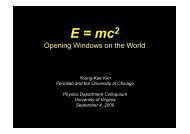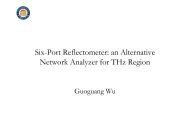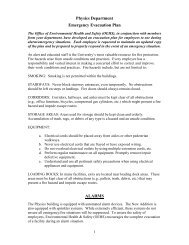Hydrodynamic Noise and Bjorken Expansion
Hydrodynamic Noise and Bjorken Expansion
Hydrodynamic Noise and Bjorken Expansion
Create successful ePaper yourself
Turn your PDF publications into a flip-book with our unique Google optimized e-Paper software.
<strong>Hydrodynamic</strong> <strong>Noise</strong> <strong>and</strong> <strong>Bjorken</strong> <strong>Expansion</strong> – p. 1/22<br />
<strong>Hydrodynamic</strong> <strong>Noise</strong> <strong>and</strong> <strong>Bjorken</strong> <strong>Expansion</strong><br />
M. Stephanov<br />
U. of Illinois at Chicago<br />
with J. Kapusta <strong>and</strong> B. Müller
<strong>Hydrodynamic</strong> <strong>Noise</strong> <strong>and</strong> <strong>Bjorken</strong> <strong>Expansion</strong> – p. 2/22<br />
Strong interactions<br />
Nuclear force holds protons/neutrons together<br />
in a nucleus.<br />
This is the force that makes the Sun shine.<br />
Like van-der-Waals forces in ED, nuclear force is<br />
a “shadow” of a much stronger force.<br />
This force holds proton’s constituents together.<br />
Like in ED the strong force field can carry waves – gluons.<br />
Unlike ED the gluon-mediated force grows with separation. Confinement.<br />
The “charge” comes in 3 varieties – colors.<br />
The QFT of the gluons <strong>and</strong> quarks – Quantum Chromodynamics.<br />
QCD is the most elegant piece of the St<strong>and</strong>ard Model.<br />
The quest to “solve” QCD produced the most advanced ideas <strong>and</strong> tools in<br />
Theoretical Physics – from Lattice to String theory.
<strong>Hydrodynamic</strong> <strong>Noise</strong> <strong>and</strong> <strong>Bjorken</strong> <strong>Expansion</strong> – p. 3/22<br />
Quark-Gluon Plasma<br />
Can the gas of color-neutral nucleons be “ionized”?<br />
Can the (confined) quarks be set free by heating the gas of hadrons to<br />
extremely high temperature, revealing the QCD constituents <strong>and</strong> the “color”<br />
forces?<br />
Quark-Gluon Plasma.<br />
What temperature would be needed?<br />
k B T = c/R proton ∼ 200 MeV (over 10 5 of T in the Sun’s core)<br />
The Universe was that hot (<strong>and</strong> hotter) at the beginning.<br />
Today we can recreate such conditions by smashing large atomic nuclei.<br />
RHIC<br />
LHC
<strong>Hydrodynamic</strong> <strong>Noise</strong> <strong>and</strong> <strong>Bjorken</strong> <strong>Expansion</strong> – p. 4/22<br />
Lattice<br />
QCD is a quantum field theory, i.e., everything measurable<br />
is, in principle, predictable: hadron masses,<br />
scattering amplitudes, equation of state, etc.<br />
The theory says “calculate path integral” (Feynman), i.e., a weighted sum<br />
over all space-time trajectories of the variables, i.e., the fields.<br />
It is an infinitely difficult problem (for a non-trivial theory), because the number<br />
of variables (<strong>and</strong> integrations) is ∞.<br />
Lattice approach allows to reach this infinity gradually, by starting on a<br />
coarse, finite lattice <strong>and</strong> refining it. QCD on the lattice (Wilson).<br />
The question the lattice can answer is: what happens in QCD at finite T in<br />
equilibrium?<br />
E.g., how does energy density, pressure, entropy, etc. depend on T ?<br />
Does hardron gas become QGP at T ∼ 200 MeV? Yes, it does.<br />
But non-equilibrium (e.g., transport) properties are still a challenge for today’s<br />
lattice methods.
<strong>Hydrodynamic</strong> <strong>Noise</strong> <strong>and</strong> <strong>Bjorken</strong> <strong>Expansion</strong> – p. 5/22<br />
Heavy-ion collision<br />
Heavy-ion collision creates matter in not quite as<br />
static a state as what we can study on the lattice.<br />
The created fireball evolves (explodes): “little bang”.<br />
Transport properties are important.<br />
Detectors measure the particle type <strong>and</strong> momentum<br />
distributions in the final state, when the density<br />
drops so that the particles free-stream – freeze-out.<br />
dN/dy<br />
10<br />
2<br />
s NN<br />
=200 GeV<br />
10<br />
This state is thermal, with temperature about<br />
160 MeV.<br />
Similarity to BB <strong>and</strong> CMB.<br />
1<br />
−1<br />
10<br />
Data<br />
π +<br />
STAR<br />
PHENIX<br />
BRAHMS<br />
Model, χ 2 /N df<br />
=29.7/11<br />
3<br />
T=164 MeV, µ = 30 MeV, V=1950 fm<br />
b<br />
−<br />
π<br />
+<br />
K<br />
−<br />
K p p Λ Λ<br />
Ξ −<br />
Ξ +<br />
Ω φ d d K* Σ * Λ*
<strong>Hydrodynamic</strong> <strong>Noise</strong> <strong>and</strong> <strong>Bjorken</strong> <strong>Expansion</strong> – p. 6/22<br />
<strong>Hydrodynamic</strong> description<br />
The hydrodynamic description of the heavy ion collision<br />
goes back to L<strong>and</strong>au (1953).<br />
Glauber<br />
Approach: take the equation of state, set<br />
initial conditions, <strong>and</strong> solve hydrodynamic<br />
equations to get particle yields, spectra, etc.<br />
Good agreement with data.<br />
v 2<br />
0.1<br />
0.08<br />
η/s=10 -4<br />
0.06<br />
0.04<br />
η/s=0.08<br />
0.02<br />
η/s=0.16<br />
PHOBOS<br />
Sensitive to viscosity. (Azimuthal asymmetry) 0<br />
0 100 200 300 400<br />
N Part<br />
Recent interest is due to the remarkably small implied value of viscosity.<br />
Expressed as the ratio η/s it is much smaller than one would predict in a<br />
weakly-coupled QCD plasma (Arnold-Moore-Yaffe, 2003).<br />
The ratio η/s is a measure of the coupling strength.<br />
For weak coupling η s ∼ 1<br />
– must be large.<br />
(coupling)<br />
2<br />
AdS/CFT calculation in SYM theory at infinite coupling: η/s = 1/(4π).<br />
QGP at RHIC is not a gas, but a very good (perfect?) liquid. sQGP.
<strong>Hydrodynamic</strong> <strong>Noise</strong> <strong>and</strong> <strong>Bjorken</strong> <strong>Expansion</strong> – p. 7/22<br />
Fluctuations <strong>and</strong> viscosity<br />
Can viscosity be measured in a different,<br />
complementary way?<br />
Idea: fluctuation-dissipation theorem requires<br />
fluctuations (hydrodynamic noise) <strong>and</strong><br />
dissipation (viscosity) to be proportional to<br />
each other.<br />
The magnitude of fluctuations (correlations)<br />
can be measured.<br />
The hydrodynamic correlations can be determined<br />
theoretically <strong>and</strong> depend on viscosity.<br />
Correlations over large ∆η are induced<br />
by local fluctuations (hydrodynamic noise)<br />
propagating with the speed of sound.<br />
Similarity to the fluctuations in the CMB.<br />
KΗ<br />
3.0<br />
2.5<br />
2.0<br />
1.5<br />
1.0<br />
0.5<br />
0.0<br />
0.5<br />
0 1 2 3 4 5 6<br />
Η
<strong>Hydrodynamic</strong> <strong>Noise</strong> <strong>and</strong> <strong>Bjorken</strong> <strong>Expansion</strong> – p. 8/22<br />
Relativistic <strong>Hydrodynamic</strong>s<br />
<strong>Hydrodynamic</strong>s: the effective theory for slow, long scale variations of the variables<br />
characterizing local thermal equilibrium.<br />
Variables: conserved quantities – energy, momentum, charge densities.<br />
Equations: conservation laws – ∇ µ T µν = 0, ∇ µ J µ = 0.<br />
Defining variables involves chosing the local rest frame: T 00 = ǫ, J 0 = n.<br />
Simplifying choice(s): T 0i = 0 (L<strong>and</strong>au) or J i = 0 (Eckart).<br />
Use 3 components of u µ instead of momentum density.<br />
The 4 equations involve 10 components of T µν . Thus the remaning 6 must be<br />
expressed in terms of ǫ <strong>and</strong> u µ .<br />
In equilibrium the medium is homogeneous <strong>and</strong> (T 00 = ǫ, T 11 = p, . . . )<br />
T µν<br />
eq = ǫu µ u ν − P(ǫ)(g µν − u µ u ν ).<br />
∇ µ T µν<br />
eq = 0 is ideal hydrodynamics.
<strong>Hydrodynamic</strong> <strong>Noise</strong> <strong>and</strong> <strong>Bjorken</strong> <strong>Expansion</strong> – p. 9/22<br />
Viscous hydrodynamics<br />
Deviations from equilibrium are due to (slow) spatial variations of ǫ <strong>and</strong> u µ . I.e.,<br />
T µν = T µν<br />
eq + (gradients of ǫ <strong>and</strong> u µ )<br />
| {z }<br />
∆T µν<br />
Subject to ∆T µν u ν = 0 (T µν u ν = ǫu µ by definition), the most general form is<br />
(∆ µ = h µν ∇ ν , h µν = g µν − u µ u ν )<br />
∆T µν = η<br />
»<br />
∆ µ u ν + ∆ ν u µ − 2 –<br />
3 hµν (∇ · u) − ζh µν (∇ · u)<br />
Second law of thermodynamics for entropy s = β(ǫ + P) flow<br />
∇ µ (su µ ) = −β∆T µν ∇ µ u ν = η<br />
2T<br />
»<br />
∆ µ u ν + ∆ ν u µ − 2 – 2<br />
3 hµν (∇ · u) + ζ T<br />
(∇ · u)2
<strong>Hydrodynamic</strong> <strong>Noise</strong> <strong>and</strong> <strong>Bjorken</strong> <strong>Expansion</strong> – p. 10/22<br />
Fluctuations <strong>and</strong> <strong>Noise</strong><br />
So far hydro. eqns. describe evolution of the average values of the variables. In a<br />
thermodynamic ensemble the variables fluctuate.<br />
The origin of the noise is local, but these fluctuations propagate according to<br />
hydrodynamic equations. I.e., hydrodynamics can describe long-range<br />
correlations.<br />
This means<br />
∆T µν = ∆T µν<br />
visc + Sµν .<br />
Locality means ˙ S µν (x)S αβ (0) ¸ ∼ δ 4 (x). The magnitude is determined by the<br />
condition that the equilibrium distribution is given by e S (Einstein).
<strong>Hydrodynamic</strong> <strong>Noise</strong> <strong>and</strong> <strong>Bjorken</strong> <strong>Expansion</strong> – p. 11/22<br />
Fluctuations <strong>and</strong> <strong>Noise</strong><br />
Generically, for a system of many variables x i , obeying<br />
ẋ i = − X j<br />
γ ij X j + y i<br />
where X j = −∂S/∂x i , the required noise is 〈 y i (t)y j (0) 〉 = (γ ij + γ ji )δ(t).<br />
Applying to x i ∼ ǫ, u µ one finds<br />
D<br />
E<br />
S µν (x)S αβ (0) = 2T<br />
» “<br />
η h µα h νβ + h µβ h να” +<br />
„ζ − 2 « –<br />
3 η h µν h αβ δ 4 (x)<br />
This, with T µν = T µν<br />
eq + ∆T µν<br />
visc + Sµν defines a system of stochastic equations<br />
∇ µ T µν = 0.<br />
The correlation functions of T µν can be now calculated by solving in terms of S µν .<br />
Usually, this is applied to fluctuations around a static equilibrium solution. Our goal<br />
is to apply this to determine correlations in an exp<strong>and</strong>ing fireball.
<strong>Hydrodynamic</strong> <strong>Noise</strong> <strong>and</strong> <strong>Bjorken</strong> <strong>Expansion</strong> – p. 12/22<br />
<strong>Bjorken</strong> expansion<br />
<strong>Bjorken</strong> (1983) suggested that the central region of the heavy-ion collisions can be<br />
described by a solution of the hydrodynamic equations which is boost-invariant.<br />
The <strong>Bjorken</strong> flow is conveniently viewed in <strong>Bjorken</strong> coordinates:<br />
t<br />
t = τ cosh ξ <strong>and</strong> z = τ sinh ξ.<br />
In these coordinates the fluid is at rest locally: u µ = (1, 0,0 ⊥ ) Bj .<br />
z<br />
The average quantities depend only on τ. But the fluctuations depend also on ξ<br />
<strong>and</strong> x ⊥ , e.g., ǫ = ǫ 0 (τ) + δǫ(τ, ξ, x ⊥ ).<br />
We integrate (average) over x ⊥ <strong>and</strong> consider, effectively, a 1+1 dimensional<br />
problem. In this case S µν u ν = 0 means<br />
where f is r<strong>and</strong>om noise (w = ǫ + p)<br />
〈 f(ξ 1 , τ 1 )f(ξ 2 , τ 2 ) 〉 = 2T(τ 1)<br />
Aτ 1 w 2 (τ 1 )<br />
S µν = w(τ)f(ξ, τ)h µν<br />
» 4<br />
3 η(τ 1) + ζ(τ 1 )–<br />
δ (τ 1 − τ 2 ) δ (ξ 1 − ξ 2 )
<strong>Hydrodynamic</strong> <strong>Noise</strong> <strong>and</strong> <strong>Bjorken</strong> <strong>Expansion</strong> – p. 13/22<br />
<strong>Hydrodynamic</strong> equations<br />
The only nontrivial function is ǫ(τ), <strong>and</strong> it obeys<br />
d(τs)<br />
dτ<br />
= ν<br />
τT s<br />
I.e., entropy per unit rapidity, τsA, increases only due to viscosity.<br />
Convenient notation: ν ≡ (4η/3 + ζ)/s.<br />
E.g., for s ∼ T 3 ⇒ T ∼ τ −1/3 + visc. corrections
<strong>Hydrodynamic</strong> <strong>Noise</strong> <strong>and</strong> <strong>Bjorken</strong> <strong>Expansion</strong> – p. 14/22<br />
<strong>Hydrodynamic</strong> equations for fluctuations<br />
Fluctuations, ǫ = ǫ 0 (τ) + δǫ(ξ, τ), u z = sinh(ξ + ω(ξ, τ)), obey<br />
τ ∂δǫ<br />
∂τ<br />
+ δw + wf −<br />
δ(νs)<br />
τ<br />
+<br />
h<br />
w − 2 νs<br />
τ<br />
i ∂ω<br />
∂ξ = 0<br />
τ ∂<br />
∂τ<br />
h “<br />
ω<br />
w − νs<br />
τ<br />
”i “<br />
+2ω<br />
w − νs<br />
τ<br />
Easy to obtain by P → P + wf − νs<br />
τ<br />
”<br />
+ ∂ ∂ξ<br />
»<br />
δP + wf − δ(νs)<br />
τ<br />
“ ”<br />
1 + ∂ω<br />
∂ξ<br />
–<br />
− νs<br />
τ<br />
in ideal equations.<br />
∂ 2 ω<br />
∂ξ 2 = 0 .<br />
Convenient variable: ρ ≡ δs/s = δǫ/w. Also, Fourier transform ξ → k.<br />
Solve for X = ρ, ω in terms of f.<br />
˜X(k, τ) = −<br />
Z τ<br />
τ 0<br />
dτ ′<br />
τ ′ ˜GX (k; τ, τ ′ ) ˜f(k, τ ′ )<br />
Then calculate correlations 〈 XY 〉 using known 〈 ff 〉.
ξ 1 ξ 2<br />
τ f<br />
<strong>Hydrodynamic</strong> <strong>Noise</strong> <strong>and</strong> <strong>Bjorken</strong> <strong>Expansion</strong> – p. 15/22<br />
Correlations<br />
The equal-(proper)time correlation function at the freeze-out time τ f :<br />
C XY (ξ 1 − ξ 2 ; τ f ) ≡ 〈 X(ξ 1 , τ f ) Y (ξ 2 , τ f ) 〉 = 2 A<br />
where the Fourier transform of G XY (ξ; τ f , τ) is given by<br />
Z τ f<br />
τ 0<br />
dτ<br />
τ 3 ν(τ)<br />
w(τ) G XY (ξ 1 − ξ 2 ; τ f , τ) , (1)<br />
Thus<br />
˜G XY (k; τ f , τ) ≡ ˜G X (k; τ f , τ) ˜G Y (−k; τ f , τ) . (2)<br />
G XY (ξ 1 − ξ 2 ; τ f , τ) =<br />
Z ∞<br />
−∞<br />
dξG X (ξ 1 − ξ; τ f , τ)G Y (ξ 2 − ξ; τ f , τ) . (3)<br />
ξ<br />
τ
<strong>Hydrodynamic</strong> <strong>Noise</strong> <strong>and</strong> <strong>Bjorken</strong> <strong>Expansion</strong> – p. 16/22<br />
Solution: inviscid case, linear EOS<br />
with (for inviscid case)<br />
τ ∂ ˜ψ<br />
∂τ + D ˜ψ + ñ = 0,<br />
„˜ρ˜ω«<br />
„ « 0 ik<br />
˜ψ = ; D = D 0 ≡ 2 2 , ñ =<br />
ikv s 1 − v s<br />
„ « 1<br />
ik<br />
˜f .<br />
˜ψ(k, τ) = −<br />
Z τ<br />
τ 0<br />
dτ ′<br />
τ ′ Ũ(k; τ, τ ′ )ñ(k, τ ′ )<br />
where<br />
Ũ(k; τ, τ ′ ) = T exp<br />
j Z τ<br />
ff<br />
dτ ′′<br />
−<br />
τ ′ τ D(k, τ ′′ )<br />
′′<br />
If v 2 s ≡ dP/dǫ = const (linear EOS):<br />
Ũ(k; τ, τ ′ ) = (τ „ «<br />
′ /τ) λ − λ+ −ik<br />
2<br />
λ + − λ − −ikv s −λ −<br />
− (τ „ «<br />
′ /τ) λ + λ− −ik<br />
2<br />
λ + − λ − −ikv s −λ +<br />
.<br />
D ˜ψ ± = λ ± ˜ψ± : λ ± = α ± β; α = 1 2<br />
`1 − vs<br />
2´ ; β = p α 2 − v s2 k 2 .
<strong>Hydrodynamic</strong> <strong>Noise</strong> <strong>and</strong> <strong>Bjorken</strong> <strong>Expansion</strong> – p. 17/22<br />
Response functions <strong>and</strong> sound horizon<br />
˜G ρ (k; τ, τ ′ ) =<br />
„ τ<br />
′<br />
τ<br />
« α »<br />
cosh `β<br />
„<br />
ln(τ/τ ′ α + k<br />
2<br />
)´ +<br />
«sinh `β ln(τ/τ )´–<br />
′<br />
β<br />
Note: β = √ α 2 − v s2 k 2 is pure imaginary if |k| > (1 − v s 2 )/2v s .<br />
Acoustic oscillations.<br />
G X – meromorphic function of k. Sole singularity is at k = ∞.<br />
Cauchy theorem gives:<br />
G X (ξ; τ, τ ′ ) = 0 when |ξ| > v s ln(τ/τ ′ ) — sound horizon<br />
In the local rest frame the velocity of the front, τdξ/dτ, equals v s .
<strong>Hydrodynamic</strong> <strong>Noise</strong> <strong>and</strong> <strong>Bjorken</strong> <strong>Expansion</strong> – p. 18/22<br />
Singularities at the sound horizon<br />
Oscillatory behavior at large k translates into sound front in ξ:<br />
G ρρ (ξ; τ f , τ) =<br />
1<br />
4v s<br />
2<br />
Z ∞<br />
dk<br />
−∞ 2π eikξ ˜Gρ (k; τ f , τ) ˜G ρ (−k; τ f , τ) →<br />
„ « 2α τ ˆδ′′ (ξ − 2v s ln(τ f /τ)) + δ ′′ (ξ + 2v s ln(τ f /τ)) − 2δ ′′ (ξ)˜<br />
τ f<br />
ξ = 2v s ln(τ f /τ)<br />
τ f<br />
τ
<strong>Hydrodynamic</strong> <strong>Noise</strong> <strong>and</strong> <strong>Bjorken</strong> <strong>Expansion</strong> – p. 19/22<br />
The wake<br />
G reg<br />
ρρ ≡ G ρρ − G sing<br />
ρρ<br />
GΡΡ reg<br />
0.30<br />
0.25<br />
0.20<br />
0.15<br />
0.10<br />
0.05<br />
0.00<br />
0.05<br />
0 2 4 6 8<br />
v s 2 = 1/3 <strong>and</strong> ln(τ f /τ) = 2, 4, 6<br />
Ξ<br />
GΡΡ sing<br />
1.5<br />
1.0<br />
0.5<br />
0.0<br />
0.5<br />
1.0<br />
0 2 4 6 8<br />
σ 2 = 0.1<br />
Ξ<br />
If the dispersion was linear, there would only be the sound front. However,<br />
ω = iλ ± = iα ± √ v s2 k 2 − α 2 .<br />
Also note that one eigenvalue λ − ∼ k 2 , for k → 0.<br />
Diffusion-like, but no dissipation.<br />
G ρρ becomes Gaussian at large τ f /τ. Width ˙ ∆ξ 2 ¸ = 2v s 2 /α · ln(τ f /τ).<br />
Sum rule: R ∞<br />
−∞ dξ G ρρ(ξ; τ f , τ) = 1.
<strong>Hydrodynamic</strong> <strong>Noise</strong> <strong>and</strong> <strong>Bjorken</strong> <strong>Expansion</strong> – p. 20/22<br />
Viscosity <strong>and</strong> taming of singularities<br />
For ν = const can be solved by perturbation in<br />
Not assuming k 2 × ν to be small.<br />
τT<br />
ν<br />
τT ≪ 1.<br />
˜G ρ (k; τ, τ ′ ) =<br />
„ τ<br />
′<br />
τ<br />
« α »<br />
cosh `β ln(τ/τ ′ )´ +<br />
„α + k 2 + νk2<br />
× exp<br />
»− νk2<br />
4α<br />
« –<br />
sinh(β ln(τ/τ ′ ))<br />
2τ ′ T(τ ′ )<br />
„ 1<br />
τ ′ T(τ ′ ) − 1<br />
τT(τ)<br />
β<br />
«–<br />
For G XX (ξ; τ f , τ)) – Gaussian smearing with width<br />
σ 2 = ν α<br />
„ 1<br />
τT − 1<br />
τ f T f<br />
«
Cooper-Frye prescription:<br />
Freeze-out<br />
Z<br />
p 0 dN s<br />
d 3 p = d s d 3 σ µ p µ f s (x, p); f s (x,p) =<br />
Σ f<br />
“ ” −1<br />
e p·u/T ± 1<br />
Fluctuations ρ <strong>and</strong> ω (i.e., T <strong>and</strong> u) translate into δN:<br />
δ<br />
„ dN<br />
dη<br />
«<br />
= d sAτ f T f<br />
3<br />
(2π) 2<br />
Z<br />
dξ ρ v s 2 + ω tanh(η − ξ)<br />
cosh 2 (η − ξ)<br />
Γ<br />
„<br />
4, m «<br />
0<br />
cosh(η − ξ)<br />
T f<br />
Translation from ξ to η leads to additional (thermal) smearing.<br />
fi<br />
δ dN δ dN fl fi dN<br />
dη 1 dη 2 dη<br />
fl −1<br />
=<br />
45d s<br />
4π 4 N eff (T 0 )<br />
„ « −2<br />
ν T<br />
2 vs −2<br />
0<br />
2<br />
K(∆η) ,<br />
T f τ f T f<br />
3.0<br />
2.5<br />
2.0<br />
KΗ<br />
1.5<br />
1.0<br />
0.5<br />
0.0<br />
0.5<br />
0 1 2 3 4 5 6<br />
Η<br />
<strong>Hydrodynamic</strong> <strong>Noise</strong> <strong>and</strong> <strong>Bjorken</strong> <strong>Expansion</strong> – p. 21/22
<strong>Hydrodynamic</strong> <strong>Noise</strong> <strong>and</strong> <strong>Bjorken</strong> <strong>Expansion</strong> – p. 22/22<br />
Conclusions <strong>and</strong> Outlook<br />
<strong>Hydrodynamic</strong>s predicts long range correlations induced by thermal noise.<br />
Wake: magnitude is proportional to ν. Nontrivial consequence of expansion.<br />
Magnitude of correlations in static equilibrium is determined by the static<br />
(thermodynamic) quantities only.<br />
Ridge: need to detemine φ-dependence. Expect a narrow (thermal) peak.<br />
More realistic (numerical) calculations need to be compared with experiment.


